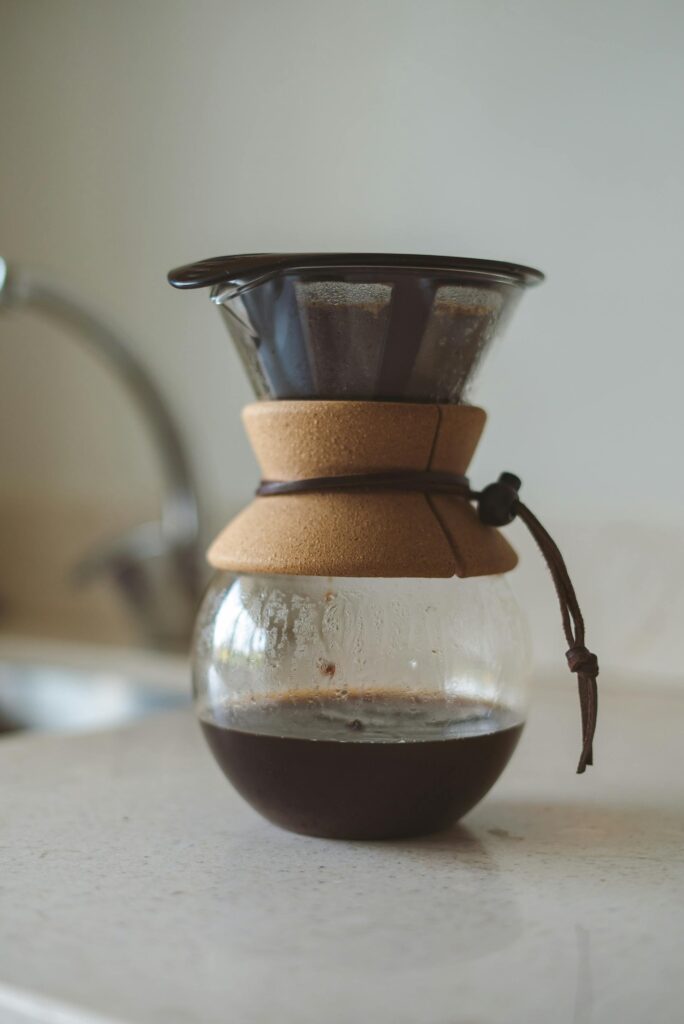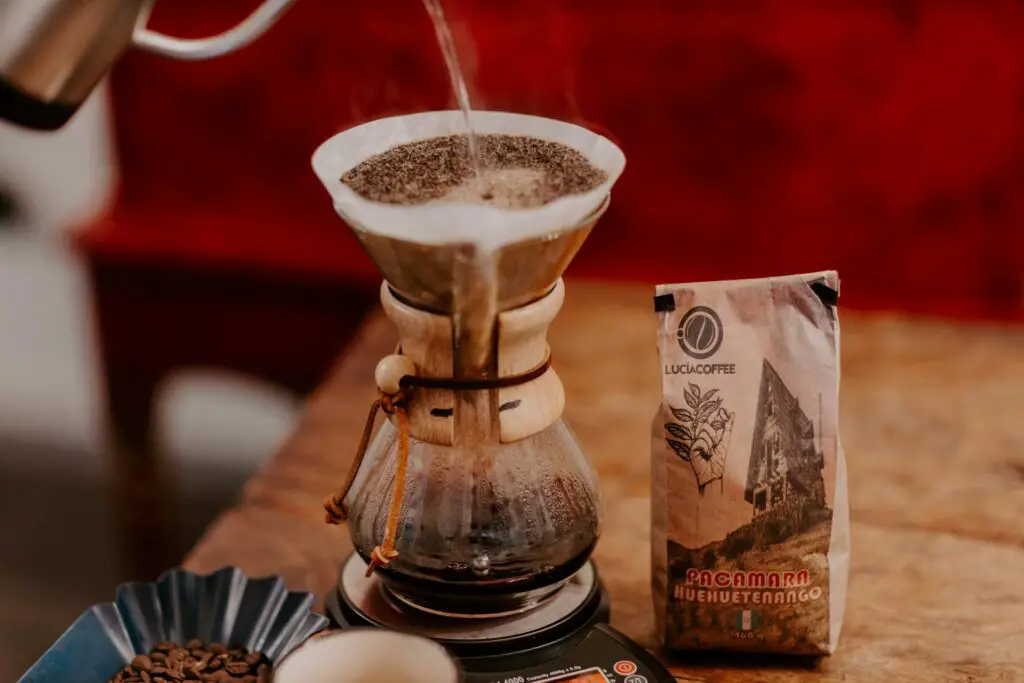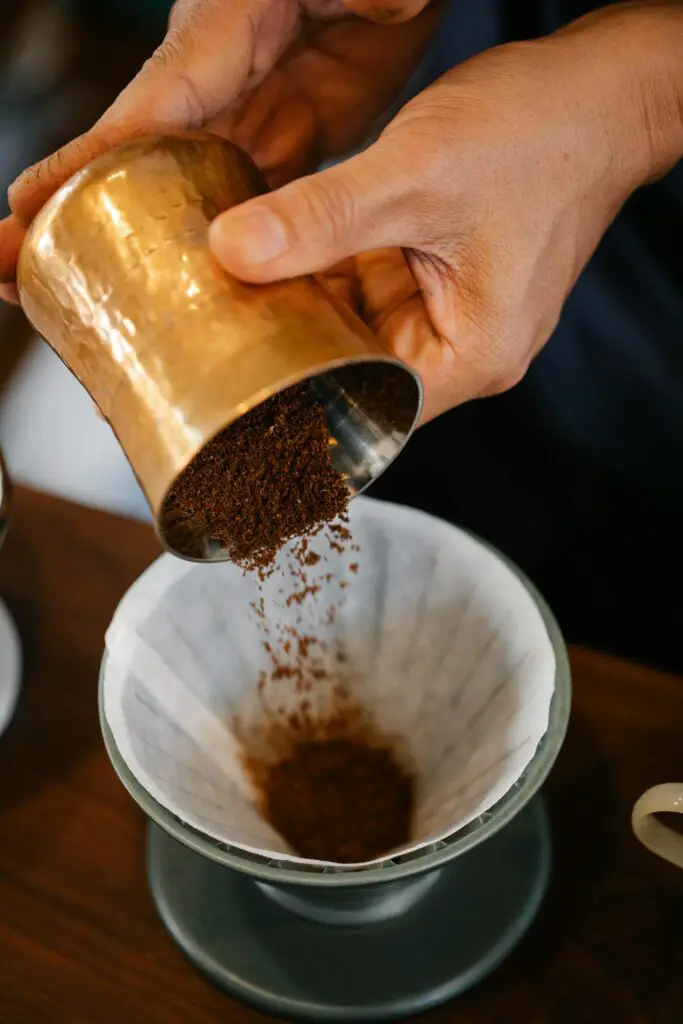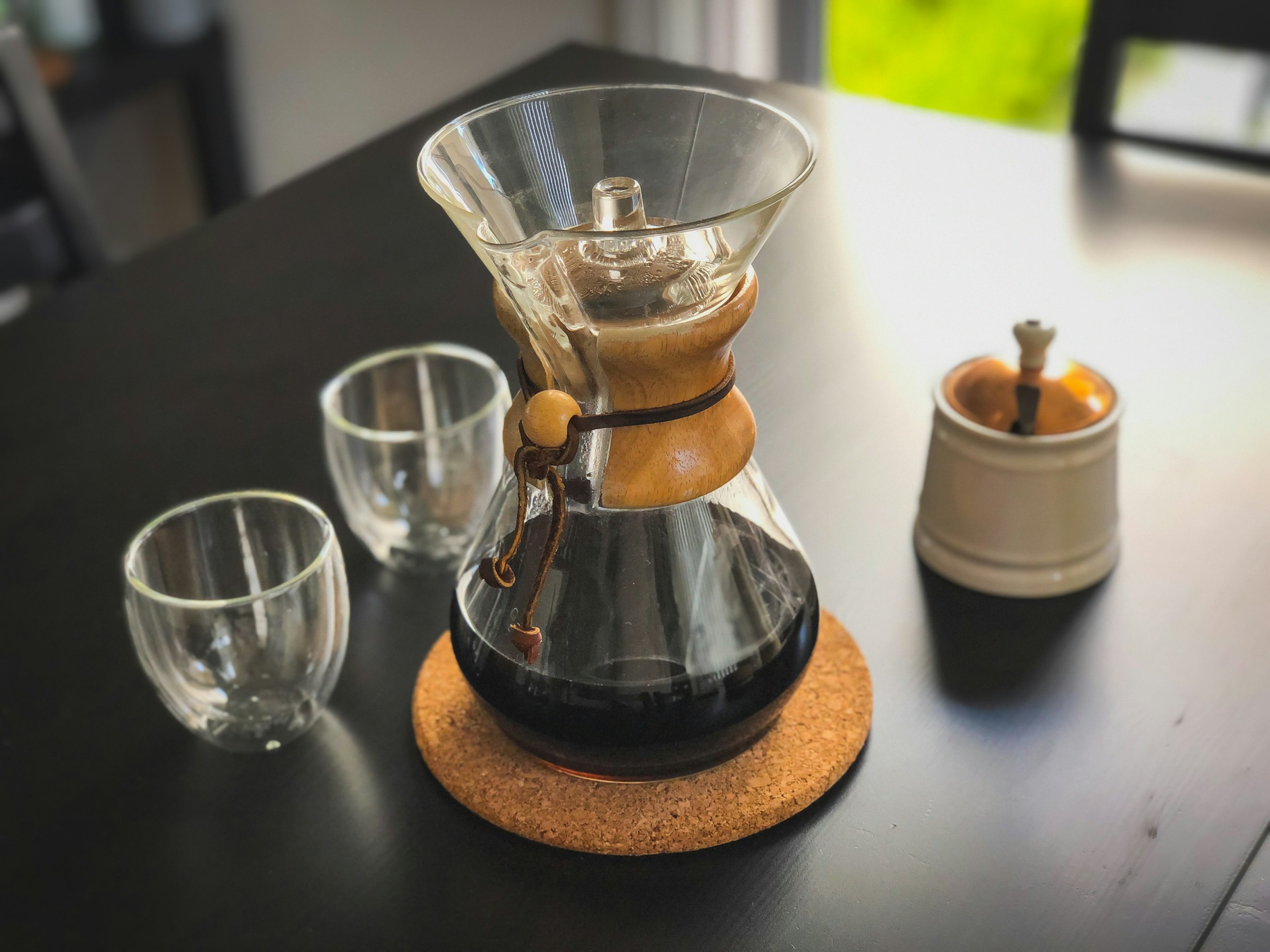The Chemex coffee maker, invented in 1941 by Peter Schlumbohm, is a staple in the world of coffee.
Its unique design, inspired by the Bauhaus school of design and laboratory equipment, makes it not only functional but also a piece of art.
This iconic coffee maker has even earned a spot in the Museum of Modern Art (MoMA) and has been featured in popular culture, including James Bond’s “From Russia with Love” and the TV show “Friends.”
In this guide, we’ll walk you through the steps to brew the perfect cup of Chemex coffee.

How To Make The Perfect Cup Of Chemex Coffee: At A Glance
- Step 1: Preparation
- Step 2: Setting Up the Chemex
- Step 3: Adding Coffee Grounds
- Step 4: Blooming
- Step 5: Main Pour
- Step 6: Finishing Up
Equipment Needed

To brew a perfect cup of Chemex coffee, you’ll need the following equipment:
- Chemex coffee maker: The heart of the brewing process, known for its elegant design and functionality.
- Chemex filters (bleached and unbleached): Essential for trapping oils and fine particles, ensuring a clean cup.
- Burr grinder (medium-coarse grind): For consistent grind size, crucial for even extraction.
- Gooseneck kettle: Offers precise control over water flow, making it easier to achieve a uniform pour.
- Digital scale: Ensures accurate measurement of coffee and water for consistency.
- Timer: Helps track bloom time and total brewing time.
- Stir stick: Useful for agitating the coffee grounds during the bloom phase.
- Freshly roasted coffee beans: For the best flavor, always use freshly roasted and ground beans.
Step-by-Step Guide

Step 1: Preparation
- Use a digital scale to measure out 42 grams of coffee beans. Accuracy is key to ensuring the perfect coffee-to-water ratio.
- Fill your kettle with 630 grams of water and heat it to a temperature between 195°F and 205°F. A gooseneck kettle is ideal for precise pouring.
- Use a burr grinder to grind your coffee beans to a medium-coarse consistency. The grind should resemble sea salt, ensuring even extraction during brewing.
Step 2: Setting Up the Chemex
- Open a Chemex filter and place it in the Chemex, ensuring the triple-fold side is facing the spout. This helps with even water flow and prevents clogging.
- Pour hot water around the inside of the filter for about 5 seconds. This step removes any paper taste and preheats the Chemex.
- Carefully discard the water used to rinse the filter, making sure the filter remains in place.
Step 3: Adding Coffee Grounds
- Pour the freshly ground coffee into the rinsed filter.
- Gently shake the Chemex to level the coffee grounds, ensuring an even bed for water to flow through.
Step 4: Blooming
- Begin your timer and slowly pour 80-100 grams of hot water over the coffee grounds. Focus on saturating all the grounds evenly.
- Allow the coffee to bloom for 30-45 seconds. This process releases trapped CO2 and prepares the coffee for full extraction.
Step 5: Main Pour
- After the bloom, continue to pour water in a steady, circular motion. Add water in 150-gram increments, waiting for each pour to drain slightly before adding more, until you reach a total of 630 grams.
- Ensure you pour in the center and avoid the edges to prevent water from bypassing the coffee grounds, which can lead to uneven extraction.
Step 6: Finishing Up
- Let all the water pass through the coffee grounds. The total brewing time should be around 4-5 minutes.
- Once brewing is complete, give the Chemex a gentle swirl to mix the coffee, ensuring a balanced flavor before serving.
Tips for the Perfect Brew

Use freshly ground coffee for the best flavor
Freshly ground coffee beans retain their aromatic oils and flavors better than pre-ground coffee.
For the best taste, grind your beans just before brewing.
Adjust grind size if brew time is too long or too short
If your coffee is taking too long to brew, the grind might be too fine.
Try a coarser grind.
Conversely, if the brew time is too short, the grind might be too coarse.
Preheat cups to maintain coffee temperature
Preheat your coffee cups with hot water before serving.
This helps maintain the coffee’s optimal temperature, ensuring every sip is enjoyable.
Experiment with coffee-to-water ratios
While a common coffee-to-water ratio is 1:15, feel free to experiment.
Some may prefer a stronger brew with less water or a milder taste with more water.
Common Issues and Solutions
Bitter Coffee
- Cause: Likely over-extracted
- Solution: Try using a coarser grind. Over-extraction happens when the water spends too much time in contact with the coffee grounds, pulling out unwanted bitter compounds. A coarser grind can help reduce the extraction time.
Weak Coffee
- Cause: Likely under-extracted
- Solution: Use a finer grind. Under-extraction occurs when the water passes through the coffee too quickly, not allowing enough time to extract the desirable flavors. A finer grind will slow down the extraction, enhancing the coffee’s strength and flavor.
Uneven Extraction
- Cause: Poor control over water flow
- Solution: Use a gooseneck kettle for better control. A gooseneck kettle allows for a precise and consistent pour, which helps in achieving an even extraction by ensuring that all the coffee grounds are evenly saturated.
Conclusion
Brewing coffee with a Chemex results in a clean, well-balanced cup that highlights the intricate flavors of the beans.
The unique design and precise brewing process make it a favorite among coffee enthusiasts.
Experiment with different grind sizes, water temperatures, and coffee-to-water ratios to find your perfect brew.
Happy brewing!


